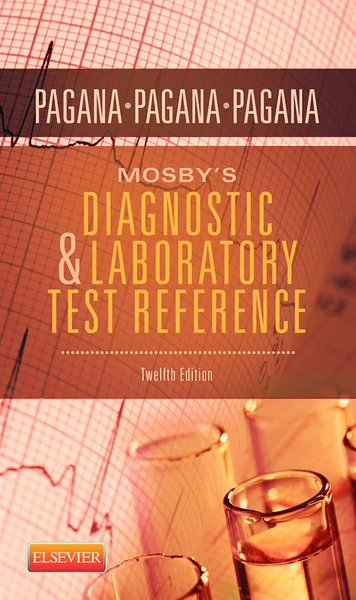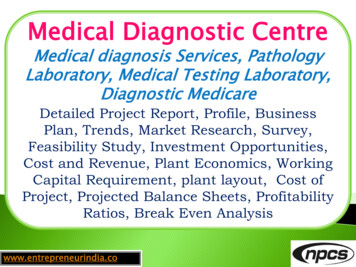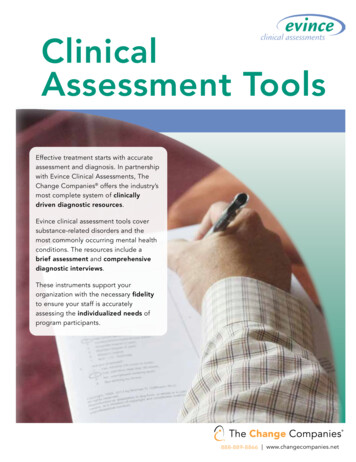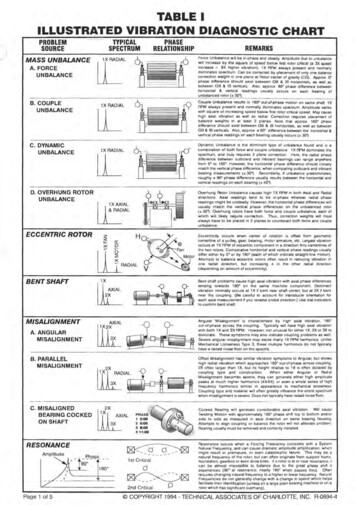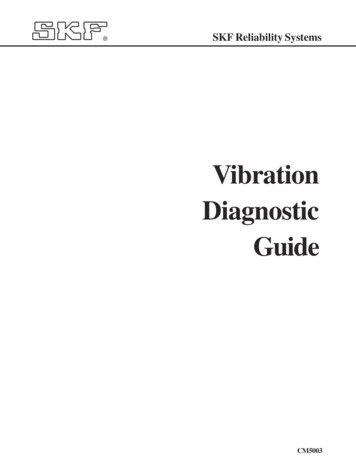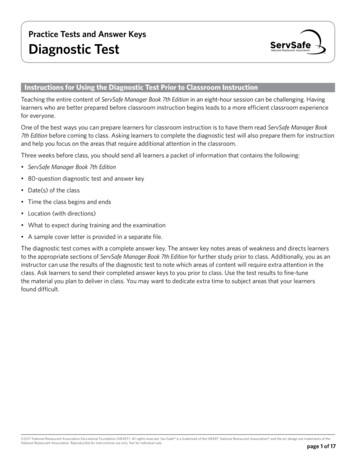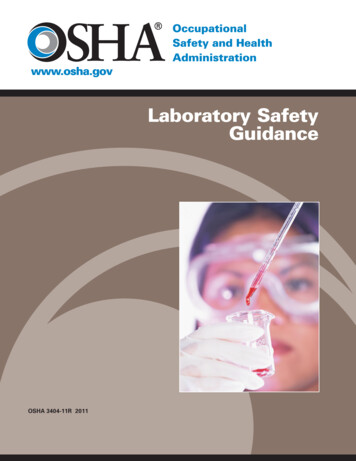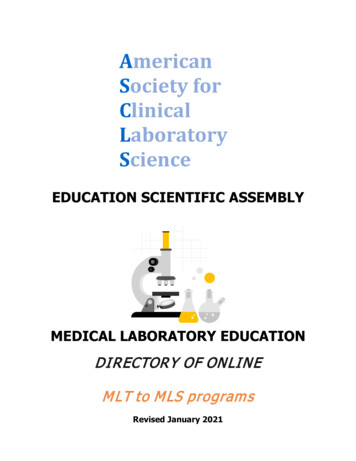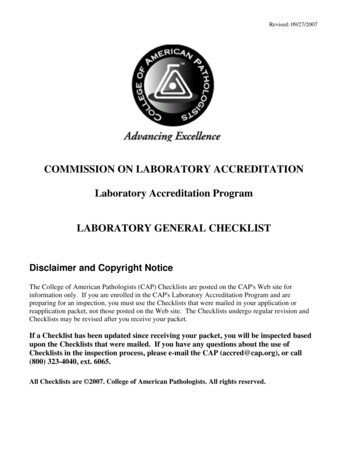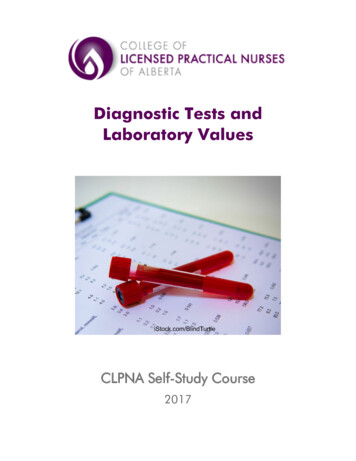
Transcription
Diagnostic Tests andLaboratory ValuesCLPNA Self-Study Course2017
AcknowledgementsThe development of this resource guide is an initiative of the College of Licensed Practical Nurses ofAlberta (CLPNA). Production of this professional development initiative has been made possible througha grant from Alberta Labour, Foreign Qualification Recognition branch.Content and ReviewDr. John Collins has attained broad experience in the fields of nursing and education. He has worked as anRN and an RPN in clinical practice, administration, research, and education. As an individual who hascompleted undergraduate, graduate, and postgraduate studies, John values the principle of lifelong learningand encourages others to follow this path with a view to providing excellence in client care.Jason Richmond is an advanced-care paramedic with experience in health care, education, and curriculumdevelopment. He is currently pursuing a master of education in distance education. Jason was the foundingchairperson of the Continuing Education Centre for Emergency Services, which continues to provide freecontinuing education. Further, he is a strong advocate for integrated practice between health professionsand open education.Editing of this module was done by Heather Buzila, who has broad editorial experience that includeseducational materials and fiction and nonfiction manuscripts.Programming and ProductionThe design and programming of this course was done by Russell Sawchuk of Steppingstones Partnership,Inc., and Learning Nurse Resources Network.Legal and CopyrightThis self-study course is intended to support the continuing education of Alberta’s Licensed Practical Nurses.This course is intended as a refresher and is not a substitute for proper accreditation or training. Alwaysfollow your employer’s proper policies and procedures. College of Licensed Practical Nurses of Alberta, 2017Published by theCollege of Licensed Practical Nurse of AlbertaSt. Albert Trail Place 13163 – 146 StreetEdmonton, Alberta T5L 4S8Tel: 780-484-8886Website: www.clpna.comEmail: profdev@clpna.comCLPNA Diagnostic Tests & Laboratory Values – P a g e i
Diagnostic Tests and Laboratory ValuesTable of ContentsIntroduction to Diagnostic Tests and Laboratory Values .1Module 1: Diagnostic Procedures .2Introduction . 2Angiography . 3Arthroscopy . 4Bone scan . 5Bronchoscopy . 6Computed Tomography (CT Scan or CAT Scan) . 7Cystoscopy . 8Doppler studies . 9Echocardiography . 10Electrocardiogram (ECG, EKG) . 11Electroencephalogram (EEG) . 12Electromyography (EMG) . 13Endoscopy . 14Magnetic Resonance Imaging (MRI) . 15Myelography . 16Pulmonary Function Tests (PFT) . 17Radiography (X-Ray) Chest, Abdomen . 18Thallium Scan . 20Tilt-table Test . 21Transesophageal Echocardiogram (TEE) . 22Ultrasound (Sonography) . 23Summary. 24Module 2: Application of Nursing Knowledge to Diagnostic Tests . 25Introduction . 25Scenarios . 25Case Studies . 26Answers . 27CLPNA Diagnostic Tests & Laboratory Values – P a g e ii
Table of ContentsModule 3. Overview of Laboratory Tests . 31Introduction . 31Common Lab Tests . 32CHEMISTRY TESTS . 33Albumin (AL) . 33Ammonia (AMM, NH3) . 34Amylase (AMY) . 35Aspartate Transaminase (AST) . 36Blood Urea Nitrogen (BUN) . 37Chloride (Cl) . 38Creatine Kinase (CK) . 39Creatinine (Cr) . 40D-dimer (DDIMER) . 41Glucose (GLU) . 42Ischemia-Modified Albumin (IMA) . 43Lactate Dehydrogenase (LDH) . 44Potassium (K) . 46Sodium (Na) . 47Troponins (cTnT & cTnI) . 48Summary . 48HEMATOLOGY TESTS . 49Complete Blood Count (CBC, Diff) . 49Components of Complete Blood Count (CBC) . 49Hemoglobin (Hgb) . 51Hematocrit or Packed Cell Volume (PCV) . 51Myoglobin (Mb) . 52Natriuretic Peptides: BNP/or NT-proBNT . 53Platelet Count (Thrombocytes) . 54White Blood Cell Count (WBC) . 55White Blood Cell Types (WBC Differential) . 56Summary . 57Coagulation Studies . 58Prothrombin Time (PT) . 58Partial Thromboplastin Time (PTT) . 59International Normalized Ratio (INR) . 60CLPNA Diagnostic Tests & Laboratory Values – P a g e iii
Table of ContentsDiabetes Studies . 61Fasting Plasma Glucose Test (FBS) . 61Oral Glucose Tolerance Test (OGTT) . 61Hemoglobin A1C (HbA1c) . 62URINE TESTS . 63Urinalysis (UA) . 63Urine C & S (Culture & Sensitivity) . 64Urine Toxicology . 65Summary . 65Module 4. Nursing Implications and Applications of Lab Values . 66Introduction . 66Questions / Case Study . 66Self-Assessment . 68Summary . 68Endnotes . 69CommentsThis resource is intended for Licensed Practical Nurses and adds to competency in nursing practice andthe safety of clients. It is recommended that the LPN refer to CLPNA’s Competency Profile for tency-program/competency-profile-for-lpns/ foradditional information regarding their scope of practice.Additional CommentsThe information found here is useful for the LPN’s role as a caregiver and educator (explaining various labtests, the collection of specimens, and preparing clients for diagnostic testing). Further reading or accessto additional resources for training purposes is recommended. Some resources are posted at the end ofthis course.CLPNA Diagnostic Tests & Laboratory Values – P a g e iv
Introduction to Diagnostic Tests & Laboratory ValuesLicensed Practical Nurses (LPNs) are responsible for providing safe, competent, and quality care to clients.It is an expectation of practice that they will critically appraise all assessment data to arrive at the bestnursing care for each client. This course provides information and learning activities related to diagnostictests and laboratory (lab) values, one source of client assessment data. An LPN should understand therationale for conducting specific diagnostic and laboratory tests when delivering care, as well as theimplications of the results of those tests. The course lists common diagnostic and lab tests and values in anorganized manner, with opportunities for participants to test their knowledge through short case studiesand interactive quizzes.PurposeAccording to Alberta’s LPN Competency Profile, an entry-level LPN meets the knowledge requirementfor obtaining, assessing, and monitoring diagnostic tests and lab values commonly used in health care. 1 Thiscourse is intended to review and extend an LPN’s knowledge pertaining to diagnostic tests and lab values sothat safe and timely care may be delivered to clients.Course OutcomesOn completion of this course participants will identify and describe commonly used diagnostic procedures and lab tests; describe commonly ordered diagnostic procedures and lab values; recognize principles of client teaching to the preparation and management of clients undergoingdiagnostic and lab testing; differentiate normal from abnormal results; andimplement appropriate action as it relates to results to maintain a safe, competent, and ethical careto clients.Course OutlineThis course consists of four modules:Module 1: Introduction to and overview of diagnostic tests. This section gives the learner a briefoverview of commonly ordered diagnostic tests used in a variety of settings where an LPN providesclient care.Module 2: Nursing implications for diagnostic tests. This module encourages the learner to applyknowledge of diagnostic tests through responding to nursing case studies.Module 3: Overview of lab values. The topics discussed in this section focus on values limited to themost commonly ordered chemistry, hematology, and urine tests.Module 4: Nursing implications for lab tests. This section provides an opportunity to integrateinformation from Module 3 to check the LPN’s competence through interactive online quizzes.CLPNA Diagnostic Tests & Laboratory Values – P a g e 1
Module 1: Diagnostic ProceduresIntroductionDiagnostic testing enables health care providers to diagnose, monitor, and treat conditions or anticipatechanges in the health statuses of individuals. LPNs are involved in both direct and indirect care ofclients where diagnostic procedures are anticipated (long-term care, maternity, pediatrics, community andpublic health, medical and surgical units in hospitals). Regardless of the nursing environment, client teachingis vital to encourage collaboration with procedures and facilitate obtaining the most accurate results. TheLPN is proactive in assisting clients undergoing diagnostic testing.The following diagnostic tests will be discussed in this module:AngiographyArthroscopyBone scanBronchoscopyComputed tomography (CT scan or CAT scan)CystoscopyDoppler studiesEchocardiographyElectrocardiogram (ECG, EKG)Electroencephalogram (EEG)Electromyography (EMG)EndoscopyMagnetic resonance imaging (MRI)MyelographyPulmonary function tests (PFT)Radiography (X-ray) chest, abdomenThallium scanTilt-table testTransesophageal echocardiogram (TEE)Ultrasound (Sonography)Module OutcomesUpon completion of this module, the participant will be able to list commonly used diagnostic tests;identify the indications for various diagnostic tests;explain the procedure(s) for various diagnostic tests;recognize interfering factors in diagnostic testing; andstate the nursing implications of diagnostic tests.Nice to Know This module uses some terminology that you should familiarize yourself with. For example, normalfindings refer to diagnostic results that are within expected or typical ranges. Indications refer to thereasons for obtaining diagnostic studies (e.g., establish a diagnosis, monitor therapy, screen for disease).Procedure relates to the preparation of the client before the test and care of the client during and afterthe test. Interfering factors refers to those factors that could influence or alter test results (e.g.,medications). Nursing implications refer to those aspects of care that are within the role of the LPN,including the need for client teaching.CLPNA Diagnostic Tests & Laboratory Values – P a g e 2
AngiographyDescription2An X-ray test that uses a special dye and camera (fluoroscopy) to take pictures of the blood flow in anartery (e.g., aorta) or a vein (e.g., vena cava). Common angiograms can look at arteries close to theheart, lungs, brain, head or neck, legs or arms, and the aorta. 3Indications To find the cause of chest pain or pressure (e.g., from myocardial infarction, angina, or pericarditis).Procedure1. A thin tube (catheter) is placed into a blood vessel in the groin or wrist (femoral or radial artery orvein) or just above the elbow (brachial artery or vein) and guided to the specific area.2. An iodine dye is injected into the vessel to make the area show clearly on X-ray pictures.Interfering Factors Movement during the filming can distort the X-ray picture.Nursing Implications Make sure the consent form is signed. Explain the procedure to the client and provide support. Instruct the client to be NPO for 8–12 hours before the test (check local policies). Discontinue anticoagulants before the test. Monitor for excessive bleeding post-test. Record vital signs pre- and post-test. Adjust vascular closure devices.CLPNA Diagnostic Tests & Laboratory Values – P a g e 3
ArthroscopyDescription4, 5This test is used to visually examine the interior of a joint with a specially designed fibre-optic endoscope.Arthroscopy permits concurrent surgery or biopsy using a technique called triangulation, in whichinstruments are passed through a separate cannula.Indications To reveal a torn meniscus, chondromalacia, dislocation, subluxation, fracture, and degenerativearticular cartilage. To assess torn anterior cruciate or tibial collateral ligaments. To diagnose Baker cysts and ganglion cysts, synovitis, and rheumatoid and degenerative arthritis. To detect foreign bodies associated with gout, pseudogout, and osteochondromatosis.Procedure1. The surgeon anesthetizes the joint, makes a small incision, and passes a cannula through the incisionand positions it in the joint cavity.2. He or she inserts the arthroscope through the cannula and examines the knee structure, takingphotographs for further study.3. After the procedure, the arthroscope is removed, the joint is irrigated, and an adhesive strip andcompression bandage are applied to the site.Interfering Factors None reported.Nursing Implications Make sure the consent form is signed. Instruct the client to fast after midnight before the procedure. Shave the area 13 cm above and below the joint. Watch for fever and swelling, increased pain, and localized inflammation at the incision site. Administer analgesics as ordered. Monitor client’s circulation and sensation in the leg. Instruct the client to report fever, bleeding, drainage, or increased joint swelling or pain. Tell the client that showering is permitted after 48 hours, but baths should be avoided until thepostoperative visit. Tell the client that he or she may resume his or her usual diet following the procedure.CLPNA Diagnostic Tests & Laboratory Values – P a g e 4
Bone ScanDescription6, 7A bone scan permits imaging of the skeleton using a scanning camera after intravenous injection of aradioactive tracer compound.Indications To help detect bone cancer. To diagnose bone trauma associated with pathological fractures and infection. To help stage cancer. To monitor degenerative bone disorders.Procedure1. The client is injected with a radioactive tracer compound that collects in bone tissue in increasedconcentrations at sites of abnormal metabolism.2. When scanned, these sites appear as hot spots that are commonly detectable months beforeradiography can reveal a lesion.3. As the scanner head moves over the body, it detects low-level radiation emitted by the skeleton andtranslates this into a chart to produce a two-dimensional picture of the scanned area.Interfering Factors A distended bladder may obscure pelvic detail.Nursing Implications Make sure the consent form is signed. Advise the client to drink lots of fluids in the interval between injection and actual scanning (aboutone to three hours). Instruct the client to void immediately before the procedure. The client may have to be repositioned several times to obtain adequate views. Check injection site for redness and swelling. After the procedure, instruct the client to drink lots of fluids and to empty bladder frequently for thenext 24–48 hours. Provide analgesics, as needed, for pain resulting from positioning on the scanning table.CLPNA Diagnostic Tests & Laboratory Values – P a g e 5
BronchoscopyDescription8The direct inspection of the larynx, trachea, and bronchi through a flexible bronchoscope. The scope has alens with a light at its distal end.Indications To detect and remove foreign bodies and secretions. To inspect the larynx, trachea, and bronchus for lesions.Procedure1. The test is conducted while the client is lying supine or in Semi-Fowler’s position withhead hyperextended.2. The bronchoscope will be inserted through the client’s nose or mouth.Interfering Factors Improper labelling of specimens.Nursing Implications Make sure the consent form is signed. Explain the procedure to the client, and provide support. Check with the department regarding NPO status. Administer pre-medications as ordered (e.g., atropine to dry the mouth). Take vital signs pre- and post-test. Advise the client that the procedure takes approximately one hour. Recognize complications post-test: laryngeal edema, bronchospasm, pneumothorax, and possiblebleeding from the biopsy site. Check for hemoptysis and the client’s gag reflex before giving food or liquids.CLPNA Diagnostic Tests & Laboratory Values – P a g e 6
Computed Tomography (CT Scan or CAT Scan)Description9, 10Pictures of the body are taken using radiation and computer-enhanced imaging.Indications To screen for coronary artery disease, head, liver, and renal lesions, tumours, edema, metastaticdisease, vascular diseases, and bone destruction.Procedure1. Consent form must be signed.2. Medications can be taken up to two hours before the test (check with radiology department).3. If contrast dye is used, usually NPO before test (eight hours before test if morning appointment). Forafternoon scheduling, NPO after full liquid breakfast (check with radiology department).Interfering Factors Presence of dentures, hairpins, jewellery for CT head. Presence of barium (an enema may be ordered).Nursing Implications Explain the procedure to the client, and provide reassurance. Ensure IV site is patent before the test. Obtain a client history of allergies to contrast dye (or allergies to seafood or iodine). Advise the client that if contrast dye is used, a warm, flushed sensation may be felt in the face orbody. Inform the client that the test may take approximately 30 minutes to one hour to complete.CLPNA Diagnostic Tests & Laboratory Values – P a g e 7
CystoscopyDescription11, 12The direct visualization of the bladder wall and urethra using a cystoscope (lighted telescopic lens). Usuallyperformed by a urologist.Indications To detect renal calculi and renal tumours. To remove renal stones. To determine the cause of UTI, dysuria, and hematuria.Procedure1. The test is conducted under local anesthesia (inserted into the urethra) or general anesthesia.2. Check with the specialist regarding NPO status before the test.3. The client lays flat with legs and feet in stirrups.4. The scope is entered through the urethra, and a sterile solution is slowly inserted to fill the bladder,making it easier to visualize.Interfering Factors None reported.Nursing Implications Make sure the consent form is signed. Explain the procedure to the client, and provide support. Offer sedation up to an hour before the test. Assess urinary patterns (amount, colour, odour). Take vital signs pre-and post-test. Inform the client that there may be some pressure or burning discomfort during and post-test.CLPNA Diagnostic Tests & Laboratory Values – P a g e 8
Doppler StudiesDescription13, 14Doppler ultrasonography evaluates blood flow in the major blood vessels of the arms and legs and withinthe extracranial cerebrovascular system.Indications To measure systolic pressure, which helps detect the presence, location, and extent of peripheralarterial occlusive disease. To detect abnormal carotid blood flow. To monitor clients after arterial reconstruction and bypass grafts.Procedure1. A handheld transducer directs high-frequency sound waves to the artery or vein being tested.2. The sound waves strike moving red blood cells and are reflected back to the transducer atfrequencies that correspond to blood-flow velocity through the vessel.3. The transducer then amplifies the sound waves to permit direct listening and graphic recording ofblood flow.Interfering Factors None reported.Nursing Implications Make sure the consent form is signed. Explain the procedure to the client, and provide support. Tell client that he or she will be asked to move arms to different positions and to perform breathingexercises as measurements are taken. Apply water-soluble conductive jelly to the tip of the transducer to provide coupling between theskin and the transducer. After the procedure, remove the conductive jelly from the skin. Take vital signs pre-and post-test.CLPNA Diagnostic Tests & Laboratory Values – P a g e 9
EchocardiographyDescription15, 16Produces an audio-visual representation of the heart and its blood flow by recording sound waves that arebounced off the organ.Indications To evaluate cardiac structures and function. To measure cardiac output (volume of blood). To identify the cause of abnormal heart sounds. To assess the damage to muscle, dysfunction of valves, and abnormality of blood flow. To evaluate myocardial disease.Procedure1. Performed with the client positioned on his or her left side.2. Acoustic gel applied to the skin over the chest.3. Transducer moved over chest and upper abdomen to obtain images.Interfering Factors Dressings and scarring of the chest may adversely affect results.Nursing Implications Explain the procedure to the client, and provide support. Inform the client that the test usually takes 15 to 45 minutes to complete.CLPNA Diagnostic Tests & Laboratory Values – P a g e 10
Electrocardiogram (ECG, EKG)Description17, 18A test that checks for problems with electrical activityof the heart. It shows this electrical activity astracings on paper/screen (called waves).Indications To find the cause of chest pain or pressure(e.g., from myocardial infarction, angina, orpericarditis). To find the cause of symptoms related tocardiac health. To determine the effectiveness of medications and check on implanted devices (pacemaker).Procedure1. Performed with client lying in a supine position.2. Certain areas on the arms, legs, and chest may be cleaned and shaved to improve electrodeadhesion.3. Several electrodes are attached to the skin on each arm, leg, and chest; these electrodes areattached to a machine that traces heart activity onto a paper.Interfering Factors Electrodes not securely adhered to the skin. Moving and talking during the test.Nursing Implications Explain the procedure to the client, and provide support. Assist in removing all jewellery from the neck, arms, an
photographs for further study. 3. After the procedure, the arthroscope is removed, the joint is irrigated, and an adhesive strip and compression bandage are applied to the site. Interfering Factors None reported. Nursing Implications Make sure the consent form is signed. Instruc
